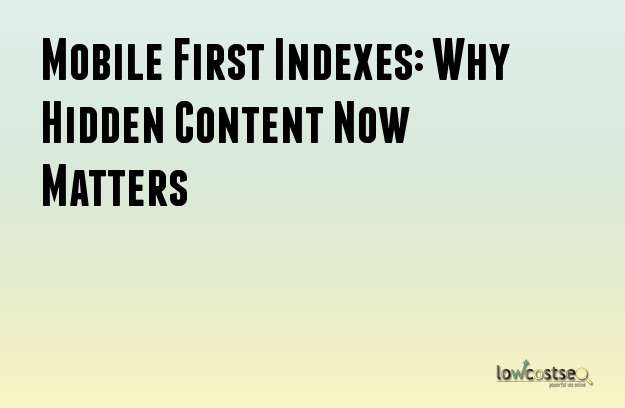
When it comes to website optimisation, one key factor that always matters is knowing which areas of the content are indexed or crawled by the likes of Google.
More than just knowing about the different header tags and text bodies, it helps to know which areas are not included in general. Footers are a common example, while carousels are bad for SEO because the crawling ‘bots often can’t read them correctly, or simply ignore them altogether.
However, with the recent introduction of a mobile first index – a searching index that gives a bigger priority to mobile platforms – this may be set to change. These hidden elements are said to carry “full weight” as far as indexing and ranking goes.
Naturally, this is big news, so what’s the best way to prepare for this? Let’s walk through some immediate options in preparing for this development.
Focus On Mobile Elements
Typically, the best way to cater to mobile platforms is to have a dedicated mobile website. You can use canonical tags to distinguish between the two, rather than having to outright redirect to a separate website and URL. However, this also means that you’re dealing with two different websites, so you only need to resolve such ‘hidden content’ on the mobile platform.
As far as we know, there are no plans to change the weighing of these factors on desktop websites. This is actually quite useful, because these elements are a great way to provide data that doesn’t contribute any important (in terms of SEO) but is still useful to the reader.
For example, it’s great for providing information such as drop down text boxes, where the content doesn’t need to be displayed until a user decides they require it (as opposed to information that is much more relevant and useful to a wider range of people on that page).
Mobile platforms, however, hate this. So change your web design and remove these elements. They only serve to slow down the loading speeds and, now, the extra text can influence your SEO results.
What If I Keep These Elements?
Of course, it may very well be possible that these elements need to stay on your mobile website. In these instances what can you do?
In short… go over all of the text and information very carefully. These widgets, carousels and other hidden additions will now contribute to a page’s overall ranking, so make sure they are optimised. At the very least, they should be free of any conflicting keywords, spam or duplicate content issues. If strong enough, this could potentially cause a penalty or negative reaction from Google.
Part of the problem, for now at least, is that we just don’t know how strongly these changes will be felt. Speaking of which...
Test Test Test
As a result, the only way to know for sure is to keep testing your pages regularly. If the mobile site suddenly spikes for no other apparent reason, this will be a strong suggestion something is going on. Of course, a positive change is beneficial, but a negative change should be assessed carefully. Make the changes and watch what happens as a result. It may take a few attempts, but like anything in SEO, this can be resolved.
So, are you prepared for the mobile first index? If you’re working as part of an SEO agency, mobile platforms are becoming something that can no longer be safely ignored.
